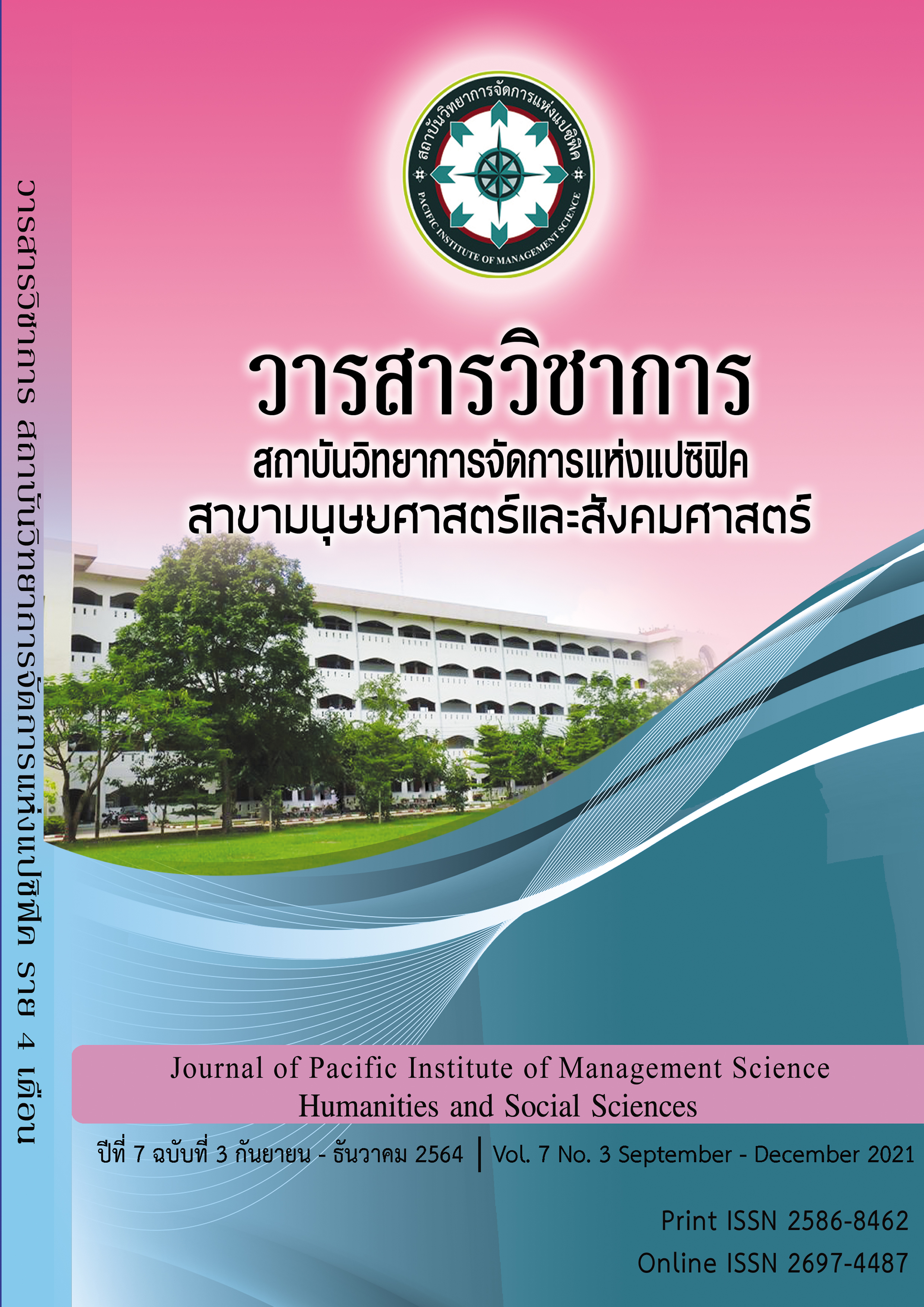Producing of Music Activities Package for Early Childhood Emotional Expressions in the Preschool Child Development Center Wat Puranawas Community Thawi Watthana District Office, Bangkok
Keywords:
Music Activities, Emotional Expressions, Early ChildhoodAbstract
The purpose of this research were 1) To design and develop a music activities package for early childhood emotional expressions in the preschool child development center Wat Puranawas community Thawi Watthana district office, Bangkok 2) To assess the effectiveness of the package. The sample group used in this study were 20 students of 1 classroom in the preschool child development center Wat Puranawas community Thawi Watthana district office, Bangkok. The research instruments consisted of a music activities package for early childhood emotional expressions and achievement test after using the package that has been quality checked by experts. The data were analyzed by computer program (Excel and SPSS) using mean and standard deviation.
The research findings were as follows: 1. The music activities package for early childhood emotional expressions that consists of 6 activities, 10 happy songs and 10 sad songs. 2. Regarding learning achievement of learners through a music activities package for early childhood emotional expressions, it is found that the mean of the posttest scores is higher than the mean of the pre-test scores at the 0.05 level. And early childhood can express music emotion of happy music more than sad music
References
กรมสุขภาพจิต กระทรวงสาธารณสุข. (2545). คู่มือกิจกรรมเสริมสร้างความฉลาดทางอารมณ์เด็กอายุ 3-11 ปี. กรุงเทพฯ: โรงพิมพ์ ร.ส.พ.
กัญญพัชร พงษ์ช้างอยู่. (2560). ผลของโปรแกรมส่งเสริมการเรียนรู้ด้วยการเล่านิทานต่อความฉลาด ทางอารมณ์และพัฒนาการทางภาษาของเด็กปฐมวัย (วิทยานิพนธ์ปริญญามหาบัณฑิต). มหาวิทยาลัยบูรพา. ชลบุรี.
นิตยา คชภักดี. (2543) ขั้นตอนการพัฒนาของเด็กปฐมวัยตั้งแต่ปฏิสนธิ ถึง 5 ปี. กรุงเทพมหานคร:โรงพิมพ์คุรุสภาลาดพร้าว.
บุญเกื้อ ควรหาเวช. (2542). นวัตกรรมการศึกษา. พิมพ์ครั้งที่ 4. กรุงเทพฯ : ศูนย์หนังสือจุฬาลงกรณ์ มหาวิทยาลัย.
นวรัตน์ งาสลัก. (2547). พัฒนาการในการรับรู้อารมณ์ต่อบันไดเสียงดนตรีในเด็กอายุ 4-8 ปี (วิทยานิพนธ์ปริญญามหาบัณฑิต). จุฬาลงกรณ์มหาวิทยาลัย. กรุงเทพ
บุษบารัตน์ ศรีนวลไสว. (2553). การพัฒนาความฉลาดทางอารมณ์ของเด็กปฐมวัยโดยใช้หนังสือนิทานประกอบภาพ (วิทยานิพนธ์ปริญญามหาบัณฑิต). มหาวิทยาลัยมหาสารคาม. มหาสารคาม
สุกรี เจริญสุข. (2538) จะฟังดนตรีอย่างไรให้ไพเราะ (พิมพ์ครั้งที่ 2), กรุงเทพฯ : Dr. Sax.
Abeles, H. F., Hoffer, C. R., & Klotman, R. H. (1984). Foundations of music education. New York: Schirmer Books.
Argstatter, H. (2015). Perception of basic emotions in music: Culture-specific or multicultural? Psychology of Music, 44(4), 674 –690.
Denham, S. A., Bassette, H. H., & Wyatt, T. (2007). “The socialization of emotional competence. In J. Grusec& P. Hastings (Eds.)”, TheHandbook of Socialization (pp. 614-637). New York: Guilford Press.
Ekman, P., Cordaro, D. (2011). What is meant by calling emotions basic. Emotion Review, 3(4), 364-370.
Fane, J. (2017). Using emoji as a tool to support child wellbeing from a strengths-based approach. Learning Communities: International Journal of Learning in Social Contexts [Special Issue: 2017 30th ACHPER International Conference], 21, 96-107.
Gallo, K.E. (2016). Understanding children's food-related emotions using words and emojis in the United States and Ghana. KE Gallo. Kansas State University, Manhattan, Kansas.
Gordon, E. E. (2003). A Music learning theory for newborn and young children(3rd ed). Chicago, IL: G.I.A.
Hargreaves, D.J. & North, A.C. (1997). The Social Psychology of Music. Oxford: Oxford University Press.
Hockenberry, M.J. (2011). Wong's nursing care of infants and children (9th ed.). St. Louis, Mo: Mosby Elsevier
Juslin, P. N., & Sloboda, J. A. (2010). Handbook of music and emotion: Theory, research, applications. Oxford, England: Oxford University Press.
Keil, C., & Campbell, S.P. (2012). Born to groove.
Mohn, C., Argstatter, H. and Wilker, F., 2010. Perception of six basic emotions in music. Psychology of Music, 39(4), pp.503-517.
Santrock, J. (2013). Childhood Development. 14th Edition, New York: McGraw-Hill Education.
Sims, W. L. (1986). The effect of high versus low teacher affect and passive versus active student activity during music listening on preschool children’s attention, piece preference, time spent listening, and piece recognition. Journal of Research in Music Education, 34, 173–191.
Sims, W. L. (2005). Effects of free versus directed listening on duration of individual music listening by pre-kindergarten children. Journal of Research in Music Education,53,78–86.
Stachó, L., Saarikallio, S., Van Zijl, A., Huotilainen, M., Toiviainen, P. (2013). Perception of emotional content in musical performances by 3–7-year-old children. Musicae Scientiae, 17(4), 495–512.
Tame, D. (1984). The secret power of music. New York: Destiny Books.
Vidas, D., Dingle, G. A., & Nelson, N. L. (2018). Children’s recognition of emotion in music and speech. Music & Science. 1, 1-10.
Zentner, M., & Earola, T. (2010) Rhythmic engagement with music in infancy. Proceedings of the National Academy of Sciencea, 107(13), 5768-5773.
Downloads
Published
Issue
Section
License
Copyright (c) 2022 Pacific Institute of Management Science

This work is licensed under a Creative Commons Attribution-NonCommercial-NoDerivatives 4.0 International License.
บทความที่ได้รับการตีพิมพ์เป็นลิขสิทธิ์ของ สถาบันวิทยาการจัดการแห่งแปซิฟิค
ข้อความที่ปรากฏในบทความแต่ละเรื่องในวารสารวิชาการเล่มนี้เป็นความคิดเห็นส่วนตัวของผู้เขียนแต่ละท่านไม่เกี่ยวข้องกับสถาบันวิทยาการจัดการแห่งแปซิฟิค และคณาจารย์ท่านอื่นๆในสถาบันฯ แต่อย่างใด ความรับผิดชอบองค์ประกอบทั้งหมดของบทความแต่ละเรื่องเป็นของผู้เขียนแต่ละท่าน หากมีความผิดพลาดใดๆ ผู้เขียนแต่ละท่านจะรับผิดชอบบทความของตนเองแต่ผู้เดียว







